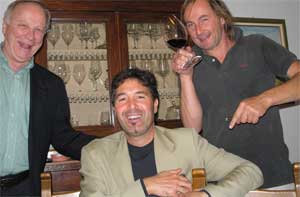A White Wine and Winery Worth Noting
© by Neil Duarte
White wine is the beverage choice for many Americans today. While California Chardonnay remains a popular selection, many white-wine drinkers are moving to wines they perceive as more dry, such as Sauvignon Blanc, or more with-it, such as Pinot Grigio.
Some white-wine fanciers fear that they are poor choices to drink with dishes that require a wine with more personality. Such a blanket condemnation is far too broad.
On a trip to Piedmont in northwestern Italy, my wife and I were introduced to a most impressive white wine made from the ancient Timorasso grape. It was bottled under the name "Derthona" from the vineyards of Walter Massa (Vigneti Massa) in Monleale (vignetimassa@libero.it).
 | |
| Neil Duarte (left), Massimo Martina and Walter Massa tasting one of Vigneti Massa's Barbara wines. Photo: Terry Duarte |
Until about 10 years ago, Vigneti Massa made its white wine from the Cortese grape, the base for the region's excellent Gavi wines. But Walter felt that the Timorasso grape would offer the possibility of a white wine that could stand up to virtually all red meat dishes and heavy cheeses.
Why were we so impressed by the Vigneti Massa Timorasso wine? The wine was served at an excellent dinner of traditional Piedmontese dishes cooked by Massimo Martina. Massimo and his wife Emanuela are the owners of Il Fiorile Ristorante and Ospitalia (www.ilfiorile.com). Their restaurant and inn is located in the quaint village Castel Ratti just outside of Borghetto di Borbera in southeastern Piedmont near the town of Gavi.
The dinner featured as its main course pork tenderloin baked in Massimo's own selection of local herbs and served with seasonal local vegetables. We had ordered a good bottle of Barbera d'Asti to accompany this course and were almost half finished the course when Massimo brought over the Vigneti Massa Timorasso.
Somewhat reluctant at first, we were amazed at how well it complemented the pork. It was full-bodied and rivaled any white wine I had ever tasted. We thanked the chef for his food and for introducing us to a new and superb white wine. Massimo and Emanuela offered to take us to Vigneti Massa and introduce us to Walter Massa.
The next day, on a cool and typically foggy fall morning in Piedmont, we traveled to Monleale. There we met Walter Massa, the reviver of the Timorasso grape and a leader in the new wave of wine makers in southeastern Piedmont.
During a tour of his winery, Walter explained his passion for this grape and clearly showed his love of wine making. As mentioned, the Timorasso wine, unlike many white wines, will age very well. Our tasting featured a 10-year-old bottle.
In addition to the Timorasso white, Vigneti Massa also produces two excellent Barberas. One, labeled "Bigolla," competes favorably with the Barbera wines of the better-known Langhe region. Later, we learned that Vigneti Massa had won the prestigious Tre Bichieri award in the 2007 Vini d'Italia Wine Guide for its 2004 Colli Tortonesi Sterpi.
The towns of southeastern Piedmont offer excellent food and superb wines in a less hectic setting than some more familiar parts of the region. Il Fiorile Ristorante and Vigneti Massa offer two top examples. Spring and fall are the best times to venture there.
August 2009
